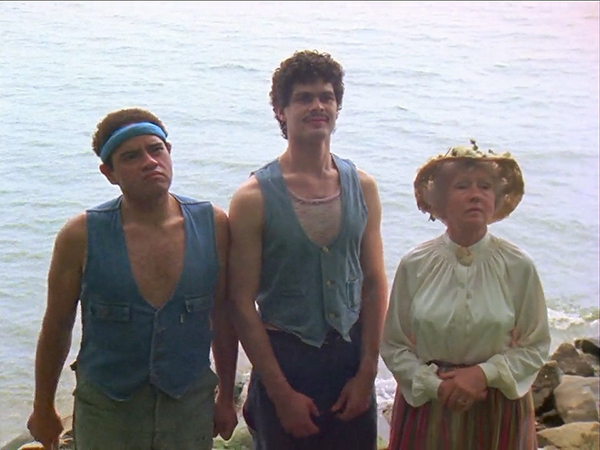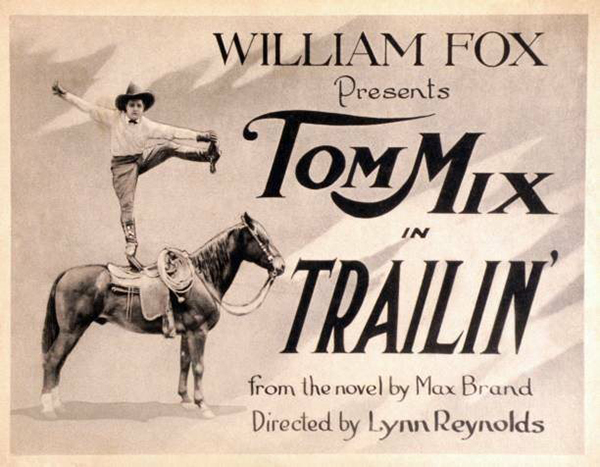2022 Federal Grant Winners
-
Adams & Morris (1958), physique modeling film by photographer Bob Mizer (Bob Mizer Foundation). Zora Lathan’s Aerial (ca. 1975) will be preserved by the National Museum of African American History and Culture, Smithsonian Institution with NFPF support.
Zora Lathan’s Aerial (ca. 1975) will be preserved by the National Museum of African American History and Culture, Smithsonian Institution with NFPF support. - Adams & Page (1958), physique modeling film by photographer Bob Mizer (Bob Mizer Foundation).
- Aerial (ca. 1975), film portrait of children at play by Zora Lathan (National Museum of African American History and Culture, Smithsonian Institution).
- After the Earthquake/Después del Terremoto (1979), fiction short on the experiences of Nicaraguan refugees in San Francisco, made by Lourdes Portillo and Nina Serrano (Berkeley Art Museum and Pacific Film Archive).
- American Pie (ca. 1975), animated collage by Zora Lathan (National Museum of African American History and Culture, Smithsonian Institution).
- ANCSA w/ Alaska Constituents (early 1970s), filmed report to constituents by Senator Ted Stevens, concerning the Alaska Native Claims Settlement Act (Ted Stevens Foundation).
- Apollo 11 Recovery Mission (1969), amateur footage by a USS Hornet crewman documenting the recovery of the module from the first spaceflight to land humans on the moon (USS Hornet Sea, Air and Space Museum).
- The Bump (ca. 1975), experimental student film by Zora Lathan, showing her mother with a professional dance instructor (National Museum of African American History and Culture, Smithsonian Institution).
- Chocolate Babies (1997), dramatic feature on the efforts of an underground band of LGBT+ activists to expose political corruption surrounding the AIDS epidemic (Frameline).
- Clumsy Boxer (1956), physique modeling film by photographer Bob Mizer (Bob Mizer Foundation).
- The Clutch of Circumstance (1918), silent melodrama starring Corinne Griffith as an actress whose marriage is imperiled by success on Broadway (George Eastman Museum).
- Cranbrook Institute of Science Collection (1935–38 & 1955–60), eight educational films produced by the Institute on biology, botany, astronomy, and geology (Cranbrook Educational Community).
-
The Cruz Brothers and Miss Malloy (1980), short feature by Kathleen Collins about three Puerto Rican brothers hired to renovate the home of an elderly Irish widow in New York (Yale Film Archive). Kathleen Collins’ The Cruz Brothers and Miss Malloy (1980) will be preserved by the Yale Film Archive with NFPF support.
Kathleen Collins’ The Cruz Brothers and Miss Malloy (1980) will be preserved by the Yale Film Archive with NFPF support. - David E. Finley Collection, Part III (1928–35), home movies of domestic life in Virginia and amateur theatricals by the first director of the National Gallery of Art (National Gallery of Art).
- Dian Fossey Gorilla Lecture Film (1973), footage accompanying Fossey’s NGS lecture on research into gorilla behavior in the Virunga mountains of East Africa (National Geographic Society).
- Doberman (Beware of Dog) (ca. 1975), experimental student film by Zora Lathan (National Museum of African American History and Culture, Smithsonian Institution).
- Drawing in School (ca. 1940s), documentation of student work at the first and only women’s art and design school in the U.S. (Moore College of Art and Design).
- England 1944 (1944), a South Carolina cotton mill–owner’s footage of the war-ravaged English textile industry (University of South Carolina, Moving Image Research Collections).
- An Equal Chance (1920), dramatized documentary produced by the National Organization for Public Health Nursing on challenges faced by medical workers during the 1918 flu epidemic (Southern Oregon Historical Society).
- Evan Hamilton Sr.: The Potlatch (ca. 1970–73), footage of a Yup’ik village elder retelling the legend of the first Yukon Delta potlatch (Alaska Moving Image Preservation Association).
- Farewell, Etaoin Shrdlu (1981), documentary by New York Times proofreader David Loeb Weiss on the last night the newspaper was printed entirely on “hot type” (New York University).
- Farmer and the Boxer (1959), physique modeling film by photographer Bob Mizer (Bob Mizer Foundation).
- Fashion Drawings (ca. 1940s), documentation of student work at the first and only women’s art and design school in the U.S. (Moore College of Art and Design).
- Fashion Show 1940 (No. 13) (1940), documentation of student work at the first and only women’s art and design school in the U.S. (Moore College of Art and Design).
- Fashion Show 1940: Philadelphia School of Design (1940), documentation of student work at the first and only women’s art and design school in the U.S. (Moore College of Art and Design).
- Flamingos on Four Continents (ca. 1958), Roger Tory Peterson’s feature length documentary on all six species of flamingo (Roger Tory Peterson Institute).
- For the Love of Money (ca. 1975), animated collage by Zora Lathan (National Museum of African American History and Culture, Smithsonian Institution).
- France 1944 (1944), a South Carolina cotton mill–owner’s footage of the war-ravaged French textile industry (University of South Carolina, Moving Image Research Collections).
- Francis Lee: Medicinemen of the Yukon Delta (ca. 1970–73), documentation of a Yup’ik village elder discussing the role of village shamans (Alaska Moving Image Preservation Association).
- Francis Lee: Whitemen and Missionaries on the Yukon Delta (ca. 1970–73), documentation of a Yup’ik village elder speaking about the first encounters between Lower Yukon native peoples and white men (Alaska Moving Image Preservation Association).
- Hiram Percy Maxim Collection (1920s–30s), 11 reels shot by the inventor and Amateur Cinema League founder, including footage of the New England Flood of 1927 and the Maxim Silencer Company headquarters (Hartford Public Library).
- If This Ain’t Heaven (1983), poetic documentary by Roberta Cantow about a middle-aged, African-American New Yorker and his cat Africa (New York Public Library).
- Immigrants in Casablanca, Belgium and Holland Tourist Scenes (1954–56), footage of a camp for Moroccan Jews heading to Israel, filmed by the JDC Executive Vice Chairman (American Jewish Joint Distribution Committee).
-
In a Vacuum (ca. 1956), film of Sybil Shearer’s solo dance on the mechanization of the individual, first performed during her 1941 debut at Carnegie Hall (Chicago Film Archives). Footage shot by aviator Royal Leonard during wartime China will be preserved by the Pan Am Historical Foundation with NFPF support.
Footage shot by aviator Royal Leonard during wartime China will be preserved by the Pan Am Historical Foundation with NFPF support. - Interior Decor (ca. 1940s), documentation of student work at the first and only women’s art and design school in the U.S. (Moore College of Art and Design).
- A Mother for Shamsi (1961), fiction short repurposed from footage of Tehran’s Jewish ghetto filmed by Mohammad Ali Issari, official cinematographer to the Shah of Iran (American Jewish Joint Distribution Committee).
- No Peace on Earth (ca. 1956), photographer Helen Morrison’s documentation of a solo dance by Sybil Shearer (Chicago Film Archives).
- North Africa #1 and # 2 (early 1950s), documentation of Jewish schools and organizations supported by the JDC in Morocco and Tunisia (American Jewish Joint Distribution Committee).
- Norton Home Movies (1948–50), home movies by a captain on the USS Hornet aircraft carrier of aircraft operations and launches (USS Hornet Sea, Air and Space Museum).
- O Lost (ca. 1956), photographer Helen Morrison’s documentation of Sybil Shearer’s dance celebration of individualism (Chicago Film Archives).
- Performer’s Dressing Room (ca. 1975), student film by Zora Lathan set backstage in Chicago’s Goodman Theater (National Museum of African American History and Culture, Smithsonian Institution).
- Refugee Children in France (1956), footage of a home used to prepare North African children for immigration to Israel (American Jewish Joint Distribution Committee).
- Refugees in Transit Camp in Marseilles, France (1956), footage of Jewish Egyptian refugees filmed by the AJJDC Executive Vice Chairman (American Jewish Joint Distribution Committee).
- The Romance of Iron and Steel (1938), sponsored film from the American Rolling Mill Company on the process of steel production, the earliest surviving work by Cinecraft Productions (Hagley Museum and Library).
- Royal Leonard Film Collection (mid-1930s to early 40s), footage shot by an elite aviator during service in wartime China (Pan Am Historical Foundation).
- Salute to Old Friends: Agnes de Mille (ca. 1956), Sybil Shearer’s solo dance tribute to a fellow dancer, set to music by the Dave Brubeck Quartet (Chicago Film Archives).
- Salute to Old Friends: Doris Humphrey (ca. 1956), Sybil Shearer’s solo dance tribute to a fellow dancer, set to music by Miles Davis (Chicago Film Archives).
- Salute to Old Friends: John Martin (ca. 1956), Sybil Shearer’s solo dance tribute to the New York Times’ dance critic, set to music by the Benny Goodman Quintet (Chicago Film Archives).
- Salute to Old Friends: Walter Terry (ca. 1956), Sybil Shearer’s solo dance tribute to the New York Herald Tribune’s dance critic, set to music by the Count Basie group (Chicago Film Archives).
- Santa (1932), melodrama produced by El Paso–based Azteca Films and directed by Spanish-American silent star Antonio Moreno, that was one of the first Mexican features made with recorded dialogue (Paso del Norte Community Foundation).
- Senator Ted Stevens Collection (early to mid-1960s), footage of Alaska Senator Ted Stevens’ family life and travels, including documentation of the 1964 Good Friday earthquake (Ted Stevens Foundation).
- Spang’s First Century (ca. 1926), feature length sponsored film about Pittsburgh-based pipe manufacturer Spang Chalfant & Co. (Pittsburgh Sound + Image).
- Spartan Mill as a Community (ca. 1938), footage of a South Carolina cotton mill town, shot by mill owner Walter S. Montgomery (University of South Carolina, Moving Image Research Collections).
- Ted Stevens and Richard Nixon (1970s), footage of Alaska Senator Ted Stevens and President Nixon in Washington D.C. (Ted Stevens Foundation).
-
Trailin’ (1921), mystery-western about a wealthy young man who goes west to learn the truth about his parents, starring Tom Mix and Eva Novak (UCLA Film & Television Archive). Trailin’ (1921), starring Tom Mix, will be preserved by UCLA Film & Television Archive with NFPF support.
Trailin’ (1921), starring Tom Mix, will be preserved by UCLA Film & Television Archive with NFPF support. - Training for Apollo 12 (1969), footage of mission crew’s spacecraft exit training in the Gulf of Mexico (USS Hornet Sea, Air and Space Museum).
- Trip Or I’m Late I’m Late (ca. 1975), abstract depiction of a journey on Chicago’s L train by Zora Lathan (National Museum of African American History and Culture, Smithsonian Institution).
- Tropical Wild Life (1957), documentation of a research field trip to Panama’s Barro Colorado Island by naturalist Paul G. Howes (Bruce Museum).
- Untitled (Moussorgsky) (ca.1956), documentation of Sybil Shearer’s dance set to Mussorgsky’s “Pictures at an Exhibition” (Chicago Film Archives).
- Walter Barth Collection, Part II (1930s–70s), home movies of a German engineer’s life and travels after immigrating to the U.S. (Knox County Public Library).
